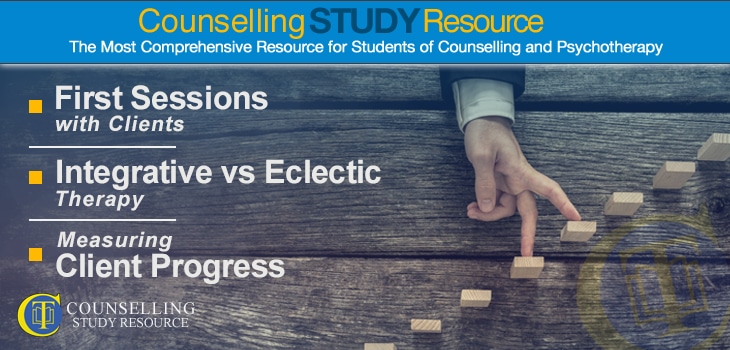039 – First Sessions with Clients – Integrative versus Eclectic Therapy – Measuring Client Progress
In episode 39 of the Counselling Tutor Podcast, Rory Lees-Oakes and Ken Kelly talk about meeting new clients for the first time. ‘Theory with Rory’ examines the difference between integrative and eclectic therapy. To conclude, the presenters talk about ways of measuring improvement in clients.
First Sessions with Clients (starts at 4.40 mins)
Rory explains that he always offers clients a drink when they arrive; he does not agree with the idea that they could ‘hide behind it’ or use it to ‘swallow their emotions’. After providing this and exchanging a few pleasantries (e.g. about how they found their journey), he goes into contracting.
Contracting can be tricky if the client immediately starts to pour out their story/issues. Ken explains that we can help prevent this by our own words at the start of a first session, for example not asking before contracting, ‘How are you feeling today?’ If it is just not possible to complete the full contract at the very start, it really is vital to cover confidentiality and its limits before letting the client open up.
Ken offers potential new clients a session of 20–30 minutes free of charge; this is specifically not a counselling session, but simply a chance to meet, provide information and discuss expectations. Of course, this may not be possible in an agency setting, where the first meeting may be the first full session.
It is not unusual for a client to talk virtually non-stop in the first session, and you may be left feeling that you have had little chance to ‘get in’ and use your skills. But this chance will come in subsequent sessions, when you can explore the material more deeply. Conversely, a new client may be very quiet. This is not necessarily therapeutic silence (even Carl Rogers admitted that some silences could be awkward and unhelpful), and Rory suggests these prompts in this situation:
- ‘I wonder how often you get the opportunity to talk about yourself.’
- ‘I wonder how you feel about the idea of talking to a stranger about your issues.’
There is also a section on opening sessions in Ken’s new book, Basic Counselling Skills: A Student Guide.
Integrative versus Eclectic Therapy (starts at 20.05 mins)
Rory uses the metaphor of a disco to explain the key difference between these two types of therapy, comparing the DJ who seamlessly segues from one genre of music to another to the DJ whose transition jars and sends people scuttling off the dance-floor to sit down!
He provides a couple of real-life examples from a past student of his, who had experienced this jarring effect when exposed to a couple of writing-based ‘homework’ techniques that had never been referred to – let alone fully explored – in subsequent counselling sessions.
However, eclecticism doesn’t have to be bad, if used carefully – it’s more akin to having a toolkit, which contains a number of possibilities, whereas the integrative approach takes various pieces and fuses them together into a new tool. Integrative approaches work best when the modalities they seek to combine have common features. For example, the fact that both person-centred counselling and cognitive behavioural therapy (CBT) focus on the here and now means that these two can be integrated to good effect. Similarly, an eclectic approach can be effective if the therapist is well grounded in one modality, but occasionally steps out of that to use a technique from another approach if that seems to best serve the needs of the client. For example, an eclectic therapist may have a person-centred basis, but move into empty-chair work (gestalt) or ask about an activating event (CBT).
For more information on the advantages and disadvantages of an integrative approach, see Rory’s downloadable handout above.
Measuring Client Progress (starts at 27.10 mins)
As a person-centred counsellor, Ken is not naturally draw to assessment forms and instead prefers to ask the client to reflect on their own progress, so that the information is coming from their frame of reference. However, many counsellors working in organisations will find that they have to use these types of tools, e.g. GAD (Generalised Anxiety Disorder), particularly where funding is based on outcome measures. It is important to be trained in how to administer these. There may also be other key performance indicators (KPIs) for counsellors, e.g. DNA (‘Did Not Attend’ rates.
However you measure client progress, it is useful to do so at least every six sessions. This is helpful for both the client (in terms of seeing their own progress) and the counsellor (for checking how we are working with them, and whether we could be doing so more effectively). Reviews also help protect clients from becoming dependent on the counsellor, and from transferential issues (e.g. if the client is coming for other reasons than to receive therapy).


